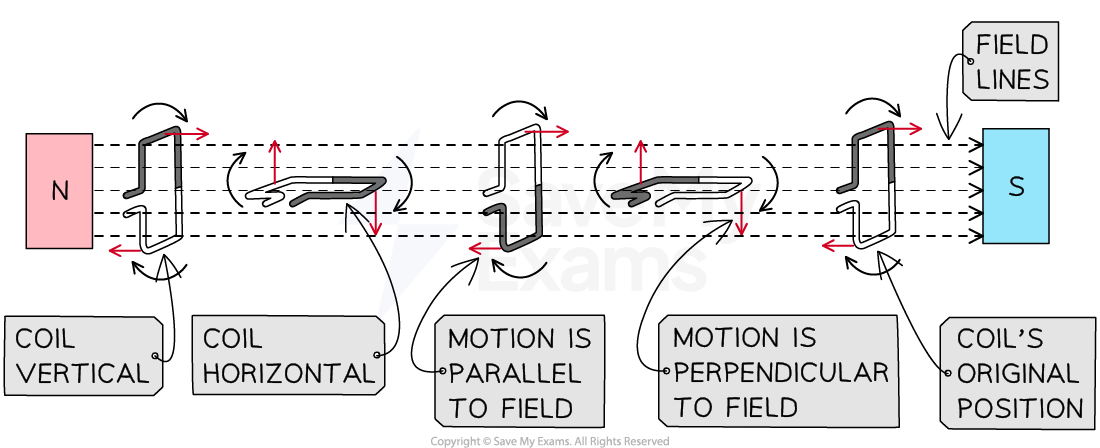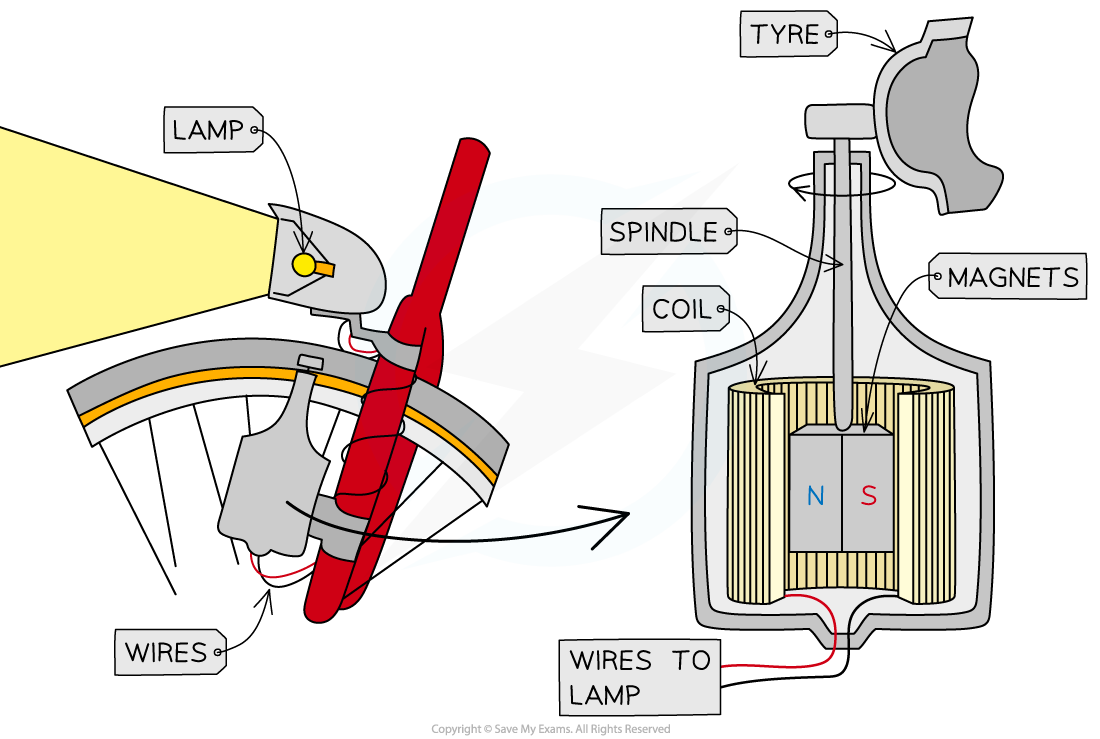Applications of the Generator Effect (AQA GCSE Physics): Revision Note
Exam code: 8463
Did this video help you?
Applications of the Generator Effect
The generator effect can be used to:
Generate a.c in an alternator
Generate d.c in a dynamo
Alternators
An alternator, or a.c. generator, is a device which converts energy from motion into an electrical output with an alternating current
An alternating potential difference (p.d.) is generated which causes an alternating current to flow
A simple alternator consists of
a rotating coil of wire between the poles of a permanent magnet
slip rings and brushes connected to an external circuit
Structure of a simple alternator

A simple alternator consists of a rotating coil in a magnetic field connected to an external circuit via slip rings and carbon brushes
The functions of each component are shown in the table:
Table of components of a simple alternator
Component | Function |
|---|---|
permanent magnet | to provide a uniform magnetic field |
rotating coil | to cut the magnetic field as it rotates and allow an induced current to flow |
slip rings | to allow the alternating current to flow between the coil and the external circuit |
carbon brushes | to provide a good electrical connection between the coil and the external circuit |
Operation of an alternator
A rectangular coil rotates in a uniform magnetic field
The coil is connected to an external circuit via slip rings and brushes
The induced p.d. in the coil can be measured by adding a galvanometer (centre-zero meter) to the external circuit
A p.d. is induced in the coil as it cuts the magnetic field
The pointer defects first one way, then the opposite way, and then back again
This indicates the size and direction of the p.d. is constantly changing
As a result of the alternating p.d., an alternating current is also produced as the coil rotates
This continues as long as the coil keeps turning in the same direction
Motion of an alternator

The size and direction of the induced p.d. (and current) depend on the orientation of the coil with the field
A maximum p.d. is induced when
the position of the coil is horizontal
the motion of the coil is perpendicular to the field
This is because the greatest number of lines are cut when the coil is moving perpendicular to the field
No p.d. is induced when
the position of the coil is vertical
the motion of the coil is parallel to the field
This is because no lines are cut when the coil is moving parallel to the field
Dynamos
A dynamo, or d.c. generator, is a device which converts energy from motion into an electrical output with a direct current
A simple dynamo contains the same components as an alternator except instead of slip rings, it uses a split-ring commutator
Structure of a simple dynamo

A dynamo is a rotating coil in a magnetic field connected to a split ring commutator
The functions of each component are shown in the table:
Table of components of a simple dynamo
Component | Function |
|---|---|
permanent magnet | to provide a uniform magnetic field |
rotating coil | to provide the rotation as the current flows through it |
split ring commutator | to allow the connection between the coil and the external circuit to change every half turn |
carbon brushes | to provide a good electrical connection between the coil and the external circuit |
Operator of a dynamo
As the coil rotates, it cuts through the field lines
This induces a potential difference between the end of the coil
The split ring commutator changes the connections between the coil and the brushes every half turn in order to keep the current leaving the dynamo in the same direction
This happens each time the coil is perpendicular to the magnetic field lines
Therefore, the induced potential difference does not reverse its direction as it does in the alternator
Instead, it varies from zero to a maximum value twice each cycle of rotation, and never changes polarity (positive to negative)
This means the current is always positive (or always negative)
The Bicycle Dynamo
A bicycle dynamo is used to supply electricity to bicycle lights whilst in motion
It consists of a rotating magnet placed inside (or next to) a coil
The magnet is rotated by its connection to the bicycle inside the coil
This is sometimes called the friction wheel and the axle / spindle
The magnetic field lines cut through the sides of the coil
This induces a potential difference in the coil
Since the magnetic field is constantly changing direction as it rotates, so does the output potential difference
This means the output current is also changing direction
Therefore, a bicycle dynamo, unlike a normal dynamo, produces alternating current (a.c)
Structure of a bicycle dynamo

A bicycle dynamo consists of a magnet rotating in a coil due to the motion of the wheels
Examiner Tips and Tricks
Motors and generators look very similar (as do microphones and loudspeakers), but they do very different things.
When tackling a question on either of them, make sure you are writing about the right one! A motor takes in electricity and turns it into motion. A generator takes in motion, and generates electricity.
You might be expected to give the explanations of how these two things happen - make sure that you understand their subtle differences!

Unlock more, it's free!
Did this page help you?